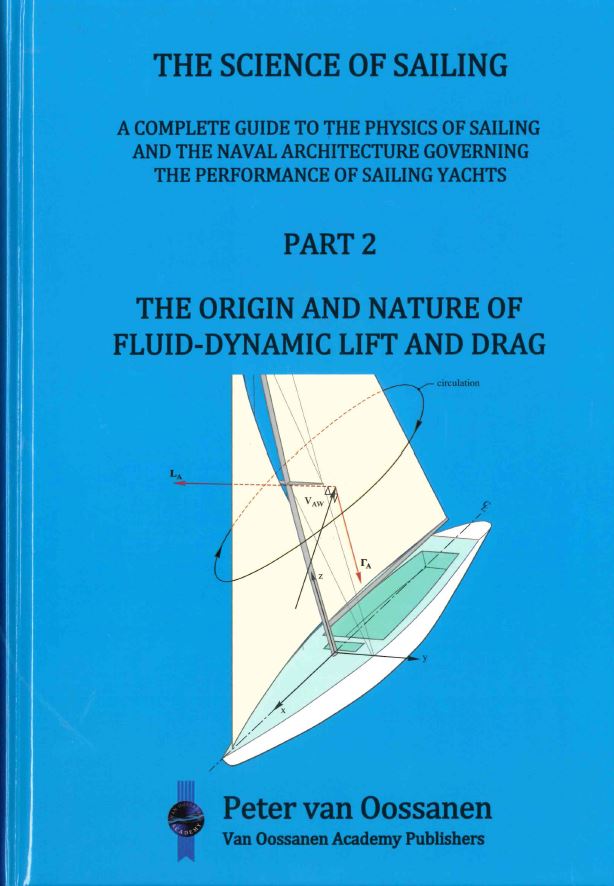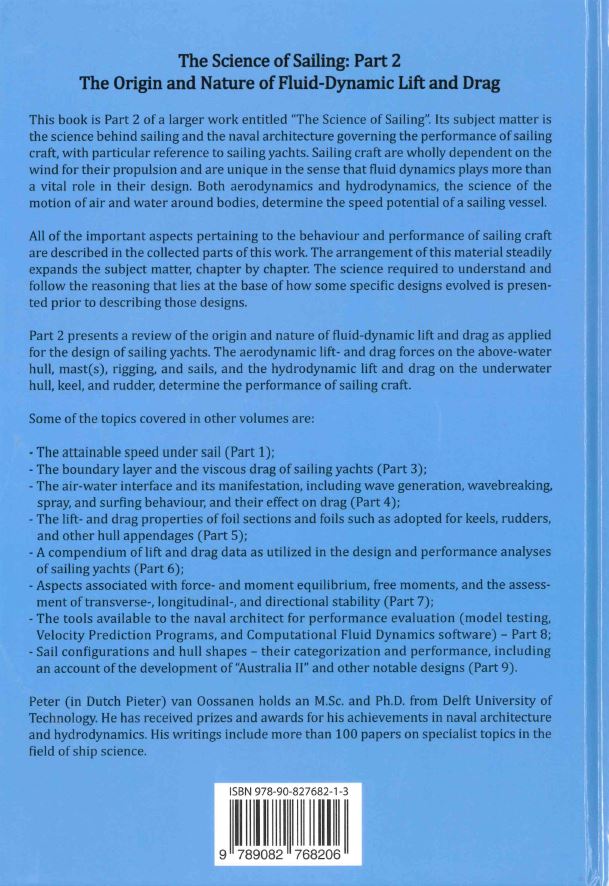Inspiration
(note from Peter)
‘The Science of Sailing’, Part 2, is entitled, ‘The Origin and Nature of Fluid-Dynamic Lift and Drag’. It is devoted to the lift and drag forces acting on a vessel propelled by sails. It consists of Chapters 5 and 6 of the complete work.
Equations were derived in Part 1 which revealed that the speed of sailing craft is primarily governed by the aerodynamic- and hydrodynamic lift- and drag forces. It is thus important that those involved in the design of wind-powered boats, yachts, and ships, have a thorough understanding of the origin and nature of fluid-dynamic lift and drag and, furthermore, possess knowledge on how to obtain high levels of lift and low levels of drag. The inspiration for Part 2, comprising Chapters 5 and 6, was the need to explain the origin and nature of fluid-dynamic lift (Chapter 5) and drag (Chapter 6).
Chapter 5 commences with a description of the origin and nature of fluid-dynamic lift, and describes how lift on a body is developed. This is followed by a derivation of the Bernoulli equation linking velocity and pressure along a streamline in the flow, and a description of some properties of the pressure distribution on a body. The concept of an ideal fluid is then introduced, followed by a concise description of classical potential flow theory the theory with which the development of a lift force on a body with circulation around it can be explained and calculated. The integration of the pressure distribution around a cylinder, for example, results in the magnitude of the lift force as a function of the circulation strength around it, thereby deriving the so-called Kutta-Joukowski theorem that expresses the relationship between lift and circulation. A method for establishing the direction of the lift vector for the three-dimensional case when (sometimes) this direction is not so obvious (as in the case of sailing craft) is also described. Finally, the ongoing discussion between aerodynamicists concerning the correct and incorrect explanation for the origin of lift is commented on.
Chapter 6 deals with the basic aspects of fluid-dynamic drag and its components. Much of the subject presented is of a general nature, applicable to all boats, yachts, and ships. The focus in this chapter is more specifically on ship-type bodies operating near the air-water interface than in the case of Chapter 5 dealing with fluid-dynamic lift. This is because near the air-water interface, bodies possess components of drag that do not appear when wholly operating in air or when deeply submerged. The researchers primarily responsible for the further development of our understanding of fluid-dynamic lift were, with few exceptions, aerodynamicists. This is not so in the case of fluid-dynamic drag. The subject still referred to as “resistance” by most workers in the field has been primarily developed by ship-oriented hydrodynamicists and naval architects. This is because the performance of ships is particularly governed by the forces opposing forward motion (more so than in the case of aircraft), and the key to solving ship-oriented performance issues requires in-depth knowledge concerning the optimum shape of hulls and hull appendages in relation to their drag characteristics. Fluid-dynamic drag is therefore treated from the perspective of the hydrodynamicist and the naval architect, although many of the topics to be considered are also of importance for the drag of sails, masts, and rigging.
A major part of Chapter 6 is devoted to a description of the additional drag incurred when the hull adopts a non-zero combination of heel, leeway, and running trim. This is of particular significance for sailing craft, which heel and adopt some degree of leeway on every course relative to the direction of the wind. This additional drag is referred to as the drag due to body attitude. One of the main components of the drag due to body attitude is associated with the lift that is generated by the hull, keel, and rudder, as soon as these adopt a non-zero angle of attack relative to the incoming flow. This component of drag is referred to as lift-induced drag. The origin and nature of this component is presented in some detail. Finally, a chart is presented dividing total drag, as found in the case of a vessel sailing in waves, into its various components by way of their dependence on Reynolds- and Froude number, and according to whether they are shear- or pressure based.

Blurb text
This book is Part 2 of a larger work entitled, ‘The Science of Sailing’. Its subject is the science behind sailing and the naval architecture governing the performance of sailing craft, with particular reference to sailing yachts. Sailing craft are wholly dependent on the wind for their propulsion and are unique in the sense that fluid dynamics plays more than a vital role in their design. Both aerodynamics and hydrodynamics, the science of the motion of air and water around bodies, determine the speed potential of a sailing vessel.
All the important aspects pertaining to the behaviour and performance of sailing craft are described in the collected parts of this work. The arrangement of this material steadily expands the subject, chapter by chapter. The science required to understand and follow the reasoning that lies at the base of how some specific designs evolved is presented before describing those designs.
Part 2, entitled, ‘The Origin and Nature of Fluid-Dynamic Lift and Drag’, presents a review of the origin and nature of fluid-dynamic lift and drag as applied to the design of sailing yachts. The aerodynamic lift- and drag forces on the above-water hull, mast(s), rigging, and sails, and the hydrodynamic lift and drag on the underwater hull, keel, and rudder, determine the performance of sailing craft.
Some topics covered in other volumes are:
- The attainable speed under sail (Part 1);
- The boundary layer and the viscous drag of sailing yachts (Part 3);
- The air-water interface and its manifestation, including wave generation, wave-breaking, spray, and surfing behavior, and their effect on drag (Part 4);
- The lift- and drag properties of foil sections and foils such as adopted for keels, rudders, and other hull appendages (Part 5);
- A compendium of lift and drag data as utilized in the design and performance analyses of sailing yachts (Part 6);
- Aspects associated with force- and moment equilibrium, free moments, and the assessment of transverse-, longitudinal-, and directional stability (Part 7);
- The tools available to the naval architect for performance evaluation (model testing, Velocity Prediction Programs, and Computational Fluid Dynamics software) – Part 8;
- Sail configurations and hull shapes – their categorization and performance, including an account of the development of “Australia II” and other notable designs (Part 9).
Peter (in Dutch Pieter) van Oossanen holds an M.Sc. and Ph.D. from Delft University of Technology. He has received prizes and awards for his achievements in naval architecture and hydrodynamics. His writings include more than 100 papers on specialist topics in the field of ship science.

Purchase information
The book is published by Van Oossanen Academy Publishers, and produced by Buijten & Schipperheijn b.v. in Amsterdam. It has a hard cover. The book comprises 188 pages. Its ISBN number is 978-90-827682-1-3. The book is sold by all major bookshops. It can also be ordered directly from Van Oossanen Academy Publishers. The following link is provided for that purpose.